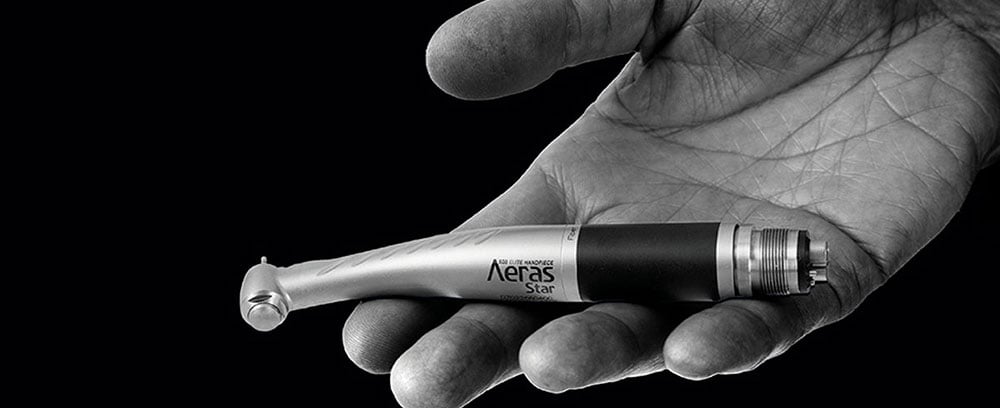We’ve been writing a lot about dental handpieces lately, and for good reason. Handpieces are the most commonly used tool in dentistry. But what are the different types of dental handpieces and what are they used for? Numerous attributes, such as rotational speed, torque, size and weight, determine what types of handpieces are used in different dental procedures.
In this article, we’ll discuss the most common types of handpieces used in dentistry, including high-speed dental handpieces, electric dental handpieces, and low-speed dental handpieces. Instead of organizing our handpiece descriptions by type, we’ve organized them by the areas of dentistry they are commonly used in, specifically general or restorative versus specialized dentistry. We hope you will find this approach helpful.
Don’t forget to check out some of our previous handpiece articles:
Handpieces for General and Restorative Dentistry
Although many dental specialties have emerged over the past several decades, general or restorative dentistry (traditionally practiced by almost all dentists) is still the most common. As you might expect, general dentistry also still uses more air-driven handpieces than electric, although that is slowly changing.
Air-Driven
Air-driven, or air turbine, handpieces still comprise a majority of the dental handpiece market for restorative dentistry in the U.S. They remain the lower cost option, both in terms of initial purchase price and cost of repair. They also offer advantages in size and weight, making them a popular option for the majority of procedures performed by a general dentist.
High-Speed Air-Driven Handpieces
High-speed air-driven handpieces are a cornerstone of general and restorative dentistry. They were the first handpieces to receive attention from dental tool innovators who were looking for a way to prep tooth structure for restorations as efficiently and painlessly as possible. As such, they are still used in 9 out of 10 procedures in a busy dental practice.
High-speed handpieces have speeds of 400,000 rpm (revolutions per minute) or more and, on contact, operate at speeds of 180,000-350,000 rpm. While they are lightweight and comfortable for dentists to use, their issues with loss of torque and concentricity when making contact with tooth structure are a disadvantage compared with electric dental handpieces. DENTALEZ’s new Aeras 500 Elite high-speed dental handpiece is the first air-driven handpiece to rival the cutting power of electric with 39 watts of power, while still being lightweight and easier to maneuver.

Low-Speed Air-Driven Handpieces
Low-speed air-driven handpiece systems are another very commonly used type of dental handpiece. Low-speed dental handpiece systems consist of air turbine motors that operate at 100-20,000 rpm and a variety of attachments used for cleaning, polishing, caries removal and endodontic procedures.
The popular DENTALEZ Titan® 3 Low-Speed Handpiece System is an award-winning low-speed handpiece system designed to provide power, torque, flexibility and control. We also recently introduced the Aeras Titan Low-Speed Motors with embedded RFID tracking to help monitor use and sterilization schedules in busy dental practices, when used in conjunction with compatible reader system.
- Read our recently published guide to dental handpiece maintenance, with helpful tips for cleaning, lubrication, sterilization, troubleshooting and repair of our air-driven dental handpieces.
Electric Handpieces
Electric dental handpieces, also called variable speed handpieces, currently make up about 30% of the restorative dentistry market in the U.S. This share is set to grow significantly in the next four to six years. Like slow-speed handpieces, electric handpieces are dental handpiece systems made up of a motor and various attachments. An electric console, or control unit, powers a brushed or brushless motor. That motor, in turn, powers various attachments that run at different speeds using gears that vary in size relative to the gear in the motor. DENTALEZ offers the Star ETorque Electric System.
High-Speed Attachments
Because they do not lose torque, electric high-speed attachments are used for more difficult restorative cases such as old crown removals. They have a 1:5 gear ratio, which allows a 40,000 rpm motor to operate at around 200,000 rpm. A red collar or dot is a visual indicator of its high-speed capability.
Low-Speed Attachments
Electric low-speed attachments are used for caries removal, preparation refinement, and adjustment of crowns and bridges. They have a 1:1 gear ratio, indicated with a blue collar or dot, which operates the bur at the same speed as the motor (40,000 rpm).
Endodontic Attachments
Endodontic attachments are slow-speed attachments used in root canal therapy. With a green collar or dot and 5:1 or greater gear ratio, endodontic attachments have a speed of 8,000 rpm or less and are ideal for the delicate work of cleaning and shaping tooth root canals.
Handpieces and Attachments for Specialized Dentistry
As dental specialties continue to grow in the U.S., these dentists often require handpieces with new capabilities and/or tweaks to already existing handpieces. The most common types of dental handpieces used in dental specialties are electric slow-speed handpiece systems, and of those, implant handpiece systems are by far the most common.
Implant Handpieces
Implant dentistry is currently the fastest growing dental specialty, due to newer technologies that make it possible such as 3D imaging and computer-guided implant placement. Implant motors and handpiece attachments are similar to standard electric handpiece systems, but have a 20:1 gear ratio that slows the drill down significantly and creates tremendous torque for surgical procedures, where penetrating bone is required.
Handpieces for Other Surgical Applications
Other surgical procedures, such as tooth extractions, canal apex resection, osteotomy, bone modeling and bone smoothing also require a low-speed dental handpiece with lots of torque. Most of these handpieces are electric, but air-driven surgical handpieces do exist. They are designed with vents toward the back that expel the air away from the oral cavity so that no air makes its way into the surgical site.
Endodontic Handpieces
Endodontic handpieces are used to perform procedures inside the tooth structure, such as root canals and related treatments. Gear transmission ratios vary, including 5:1, 8:1, 10:1 and even 16:1. There are also standalone cordless models available from multiple manufacturers.
Selecting the Best Dental Handpiece System for Your Practice
The many different types of handpieces used in dentistry can be overwhelming at first. With new innovations happening at a fast pace, it’s sometimes difficult to know how to select the best handpieces for your practice. Your practice area, whether general dentistry or a specialty, and the procedures you perform, will be the first determinant of the kind of dental handpiece system you select.
After that, you’ll want to determine your budget, and within that budget, what attributes or features are most important to you:
- Is safety and comfort for you and your staff top of mind?
- Is it materials and design, which may affect long-term durability?
- Or is it more important that you buy from an established dental supply company with a reputation for excellent customer service?
If your requirements lean more towards high-speed dental handpieces, low-speed dental handpieces, or electric dental handpieces for the most common procedures, DENTALEZ is a top company to consider. With more than 100 years of experience providing products to the dental industry, we are a trusted partner to supply your practice with handpieces that give you unmatched value for your money. We’d be happy to answer any questions you may have—just fill out our contact form or give us a call today.


